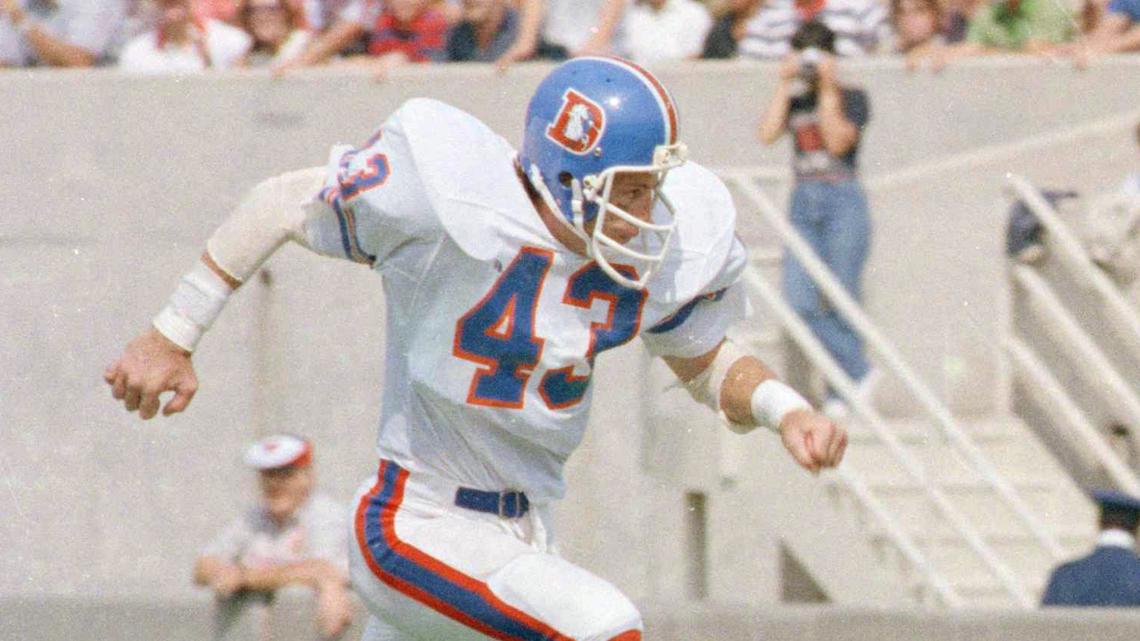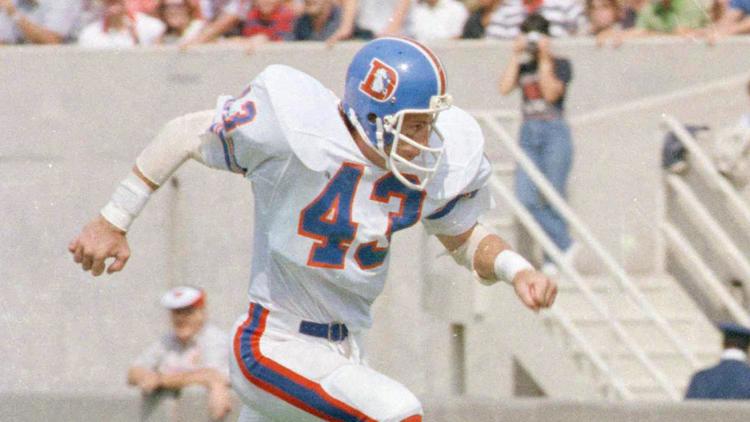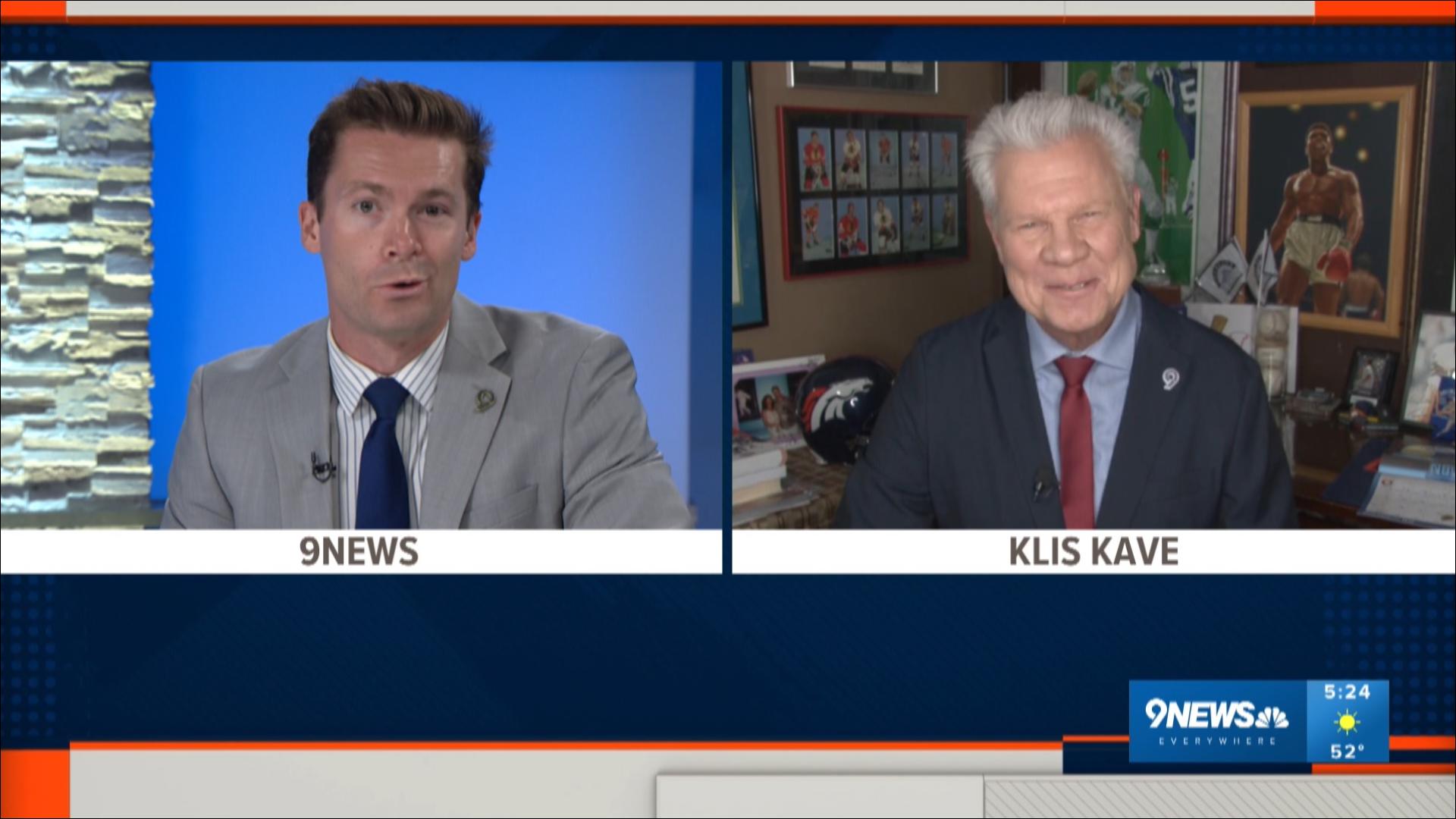DENVER — Fresh off back-to-back road wins along the East Coast, the Broncos return home for their Alumni Weekend game Sunday against their AFC West-rival Las Vegas Raiders.
The perfect opponent for former Orange Crush teammates Steve Foley and Riley Odoms to be inducted into the Broncos’ Ring of Fame.
Foley, a cornerback and safety, still holds the Broncos’ interception record 38 years after he retired with 44.
“I’ve got so many family members coming in, at least 90,’’ Foley said Wednesday. “We travel well. We’re like the Green Bay Packers.”
And the party would be larger except he has some family members and friends dealing with the devastation of Hurricane Helene in the Asheville, N.C. area.
Odoms for decades was arguably the most overlooked former Broncos’ player for the Ring of Fame honor. He was a four-time Pro Bowl tight end and three-time All Pro whose 12-year career produced more catches (396) and receiving yards (5,755) than two other top tight ends from that era – Dave Casper and Charlie Sanders -- who have long been inducted into the Pro Football Hall of Fame.
“I couldn’t go in with a better guy and as good a football player,’’ Foley said. “He was a feared force on the field. If you tried to tackle him in the open field he would crush you. And as big as he was, he had the sweetest feet. Twinkle toes at 250. He could leave you holding your jockstrap.”
The Broncos will also honor Orange Crush linebacker Randy Gradishar for his induction into the Pro Football Hall of Fame in August and the entire 1977 Broncos team that was the first to win the AFC championship and play in the Super Bowl.
The itinerary for Alumni weekend:
- Friday night gathering at Shanahan’s steakhouse.
- Saturday morning, attend practice of the current Broncos’ team at Broncos Park.
- Saturday night is the Ring of Fame ceremony at Empower Field at Mile High.
- Sunday morning is the unveiling of the Ring of Fame pillar ceremony for Foley and Odoms.
- Sunday afternoon, halftime of Broncos-Raiders game, Foley, Odoms, Gradishar and the entire 1977 team will be introduced to the fans with those three honored players delivering 60-second addresses to the crowd.
To appreciate the careers of both Foley and Odoms, 9NEWS offers excerpts from the book, “The 50 Greatest Players in Denver Broncos History,'' written by this author.
Today, the excerpt on the career of Foley:


No. 34: Steve Foley, cornerback-safety, 1976-'86
Think about what an interception is. If it were basketball they’d call the turnover a ‘steal.’ Baseball prefers the term ‘rob’ as in the center fielder robs so-and-so of a hit.
An interception, then, is stealing a pass, robbing the passer of a completion.
To rob from a quarterback, the thief is helped if he first anticipates his victim’s intentions. A quarterback may develop tendencies before throwing certain passes. They have repeated patterns of behavior, where they look before throwing, habits that can be read.
Any coincidence Steve Foley became the Denver Broncos’ all-time interceptions leader with 44 after he first grew up playing quarterback in the streets, in high school, and all the way through college before his pro team decided to move him to defensive back?
It is not.
“It was definitely an advantage,’’ Foley said in November 2016. “There were times when I saw a quarterback’s pump fake -- I did it a thousand times -- and that’s when you take off to the opposite side of the field for the deep route.
“It definitely helped. And being a quarterback, I knew the blitzes, and when we’re coming with a big blitz, small blitz, and I’d know that quarterback has one second and he’s going to feel the pressure and if he’s a young quarterback, he’s looking right where he’s going to go. It was all anticipation.
“I don’t care how fast you are, if you don’t have anticipation skills, you’ll never be around the ball.’’
Steve Foley grew up in a big Catholic family in uptown New Orleans. How big was it? It was so big, the Foleys lived in a Catholic convent. That big.
Ivan McIvor Foley, a big [6' 3"], stern and highly intelligent Irishman and certified public accountant, and his wife, the former Jane Mestayer of French descent, raised 13 children – eight sons and five daughters.
Steve was born smack dab in the middle as the seventh child. Six older siblings, six younger. Where else were the Foleys going to live?
“My father bought a Catholic convent when I was in fourth grade,’’ Foley said. “The school had burned down, it was right across the street from us. They rebuilt it, it was right next to a Catholic Church, and they had a house, an old Victorian house that was a convent. My father bought that. It was big enough for us to live in. It was uptown, 10 blocks from Tulane.
“We went to a Jesuit high school and us brothers worked our way through. Served meals, which was a bonus for us. We worked at a cafeteria, serving meals. That was the best job in the world. Because you got a bunch of food.’’
All those kids kept the Foleys young. Dad passed away in 2002 at 87. Mom lived till she was 95.
Foley made two significant position changes in his football career. The first was the most dramatic as he was shifted from quarterback to defensive back in his first professional season of 1975 with the Jacksonville Express of the World Football League. It was a position move he initially resisted.
At Jesuit High School, Foley was not only a two-year starting quarterback, he was also a fine long jumper, high jumper and javelin thrower in track. At Tulane, Foley was the Green Wave’s starting quarterback for three years. Although he ran a pro-style offense, Foley had the option-like statistics of averaging 72 yards passing and 44 yards rushing a game in his three college seasons.
If that doesn’t sound like much, consider the early-1970s era in college football. Ohio State, in back-to-back classics against Michigan in 1973-74, got 1 of 4 passing for 4 yards from quarterback Greg Hare in a 10-10 tie, and the next year the Buckeyes’ Cornelius Greene was 3 of 6 for 58 yards in a 12-10 win.
Make no mistake, Foley was a two-way, athletic threat. As a junior, he led Tulane to a 14-0 win against No. 8-ranked LSU, a 9-2 record and trip to the Bluebonnet Bowl.
He was selected by the Broncos in the eighth round, pick No. 199 overall, as a quarterback-defensive back in the 1975 NFL Draft. (Twenty-five years later, with that identical No. 199 selection, the New England Patriots would take another quarterback, Tom Brady). But in that same 1975 draft, the Broncos in the third round took a 6' 3", 220-pound quarterback out of Central Michigan named Mike Franckowiak.
“The Broncos wanted big pocket passers and not mobile quarterbacks,’’ Foley said. “We were a pro-style offense and we threw a lot, but I ran a lot, too. I loved running. I loved running track, which was kind of odd for a quarterback. Most quarterbacks don’t like to run. But I used to just love training. They drafted me because I could run. They drafted me as a possible quarterback-DB.
“But it was clear to me, I didn’t even get to warm up at quarterback. I was like, ‘Gee, what’s up?’ Not having played any defense – I played it a tiny bit in high school. Maybe my junior year I played some safety, but when I was drafted they thought I would be a good safety. They didn’t know. They didn’t know if I could hit or not. But I was pretty aggressive coming from a family of 13.’’
After one season in the WFL, Foley returned to the Broncos in 1976 and started to play cornerback. He came off the bench in the first 10 games of that season, but replaced the injured Calvin Jones as the starting right cornerback for the final six games. Foley never left the starting lineup again, except for injury and his retirement after the 1986 season.
“One of the greatest guys, ever,’’ said Tom Jackson, a starting outside linebacker all 11 seasons of Foley’s career. “And an anchor for what we did. One of the most fun and beloved guys in that locker room. We still to this day, we love each other. To this day. We all feel it when we’re together. I know when you talk to them that’s what you feel. We love each other.’’
It was halfway through the 1980 season that Broncos’ defensive coordinator Joe Collier shifted Foley from right corner to free safety. A few years earlier, Collier made the same move with Billy Thompson. And a few years after Foley’s shift, Collier arranged the cornerback-shift with Mike Harden and Tyrone Braxton.
Foley got his first interception as a safety in his third game at the position against San Diego’s Dan Fouts, returning it 30 yards. He got another the next week against the Jets’ Richard Todd, returning it 18 yards.
That was the thing about that Orange Crush defense in the late-1970s, early-1980s. They didn’t just force turnovers, they did something with them. Foley had 622 return yards with his 44 interceptions, including a 40-yard touchdown return against Seattle’s Dave Krieg in the final game of the 1984 season.
Earlier that year, in a memorable mid-October game against the Green Bay Packers played in an incredible blizzard at Mile High Stadium, Foley on the first play of the game returned a fumble 22 yards for a touchdown. On the second play of the game, Broncos cornerback Louie Wright returned a fumble 27 yards for a touchdown.
The Broncos were up, 14-0 with 37 seconds gone in the game and wound up winning, 17-14.
“That had to be the most fun game I had ever played in,’’ Foley said. “It was the closest thing to a Little League, sandlot game that you ever played in. You were falling all over. I remember hitting a 235-pound tight end and he felt like he weighed 180 pounds. I said, “This is great.’’’
Foley had 21 interceptions in his 4 ½ seasons at cornerback and 23 in 5 ½ seasons at safety. (He missed all but 1 ½ quarters in 1982 because of a broken arm suffered in the opener).
“He had great hands. Great hands,’’ said Billy Thompson, who played six seasons in the same backfield with Foley, two as a safety tandem.
“Steve was smart and he was fast enough and athletic enough to make plays,’’ said Broncos receiver Steve Watson. “And he knew what was going to happen. He was the beneficiary of Joe Collier and that (3-4) system. And they always talk about (the Chicago Bears safeties’) Doug Plank and Gary Fencik and how those guys hit. Well, I’m telling you, Foley was the same kind of hitter.’’
As a cornerback, Foley averaged 62 tackles a year in his four full years at cornerback. But it was after Thompson retired following the 1981 season that Foley really came on as a run enforcer. He was third on the team with 124 tackles in 1983, compiled a career-best 167 stops in 1984 and 92 in his final season of 1986.
In all, Foley had 877 tackles in his 11 NFL seasons. Take away his injured 1982 season and that’s 87 tackles a year. Not bad for a defensive back who was listed as 6-foot-2, 190 pounds.
“I remember one time we were playing the Houston Oilers and Earl Campbell,’’ Thompson said. “Our game plan was one guy couldn’t get Earl Campbell, we all have to gang tackle him. I remember Steve hit him – and that was one thing about Foley, he was not afraid. He would hit and that’s what set him apart. And one time he hit Earl Campbell and Earl knocked him out. I went over to him – he was lying on the field -- and I said, “Steve, are you all right?” And he said, ‘’How are the fans taking it?’’
It was Foley’s ball-hawking skills, though, that made him unique among Broncos defenders. Unlike Goose Gonsoulin, who had been the Broncos’ interception leader from the first game in franchise history in 1960 and got his picks in bunches, Foley got his interceptions at a steady pace.
Gonsoulin had 43 interceptions through his, and the Broncos’, first six seasons, an average of better than seven a year. Foley never had more than six interceptions in a season, but he had six picks three times, five interceptions twice, four picks twice and two, three-interception years.
That left him with 42 picks, one shy of Gonsoulin’s team record, heading into his final season of 1986.
“I remember around game 10, 11 every year, you’d get injuries,’’ Foley said. “Once you’d get injuries that hobble you -- you’re playing with a sprained ankle, you can’t make good plays -- it would limit you. And you knew the guy was going to have to throw the ball right to me (to get an interception). I’m not at that full speed I was in the first-half of the year. There were a few years where you’re just playing injured the last half of the season. You’re not making as many plays as you were in the beginning.’’
Foley tied Goose’s career record in game 2 of 1986, intercepting Pittsburgh’s Mark Malone with 48 seconds remaining – and returning it 24 yards, of course -- to clinch a 21-10 victory.
The record breaker came in game 4 against New England, and was probably the key play in the Broncos’ rallying for a 27-20 victory. It didn’t look that way at the 2-minute warning of the first half. The Pats were up 10-3 and had first down at the Broncos’ 11.
New England tried tricking the Broncos by having Steve James throw a halfback pass. Foley intercepted it at the 3-yard line. And yes, he returned it 15 yards to the 18.
“I was watching the linemen and they were pass blocking when they pitched it to him,’’ Foley said. “I’m like, “This is going down.’ I just took off and … yeah.’’
For the first time in 26 years, Austin “Goose” Gonsoulin was No. 2 on the Broncos’ all-time interceptions list.
Frankowiak, by the way, never threw an NFL pass. He became a 6-foot-3 running back and kick returner, if you can imagine that, and played part-time for four NFL seasons.
Foley admitted he was better off playing defense, anyway. After starting in Super Bowl XXI against the New York Giants, Foley notified coach Dan Reeves he would be hanging them up. All his Orange Crush teammates were going, too. Barney Chavous had retired in training camp of 1986. Rubin Carter got hurt in game 5 of the 1986 season and didn’t play again. Jackson and Wright also played their last game in Super Bowl XXI, a 39-20 loss.
They were the last of the Orange Crush players.
“It was a special time in Denver’s history,’’ Foley said. “It was Orange Crush defense and it was the coming of age of the Denver franchise. And getting to play Pittsburgh and Oakland (in the 1977 season playoffs), who were in the midst of their Super Bowl years. Domination years. Pittsburgh was in the midst of their four Super Bowls and we caught them in the middle there.
“As long as we had home-field advantage and beat them and Oakland to go to that first Super Bowl, that was a special, special time. We had some special defenses. Pittsburgh had the Steel Curtain. Joe Collier was the architect of the Orange Crush. Everybody loved Joe Collier. We were just excited to be playing in Joe Collier’s defense, knowing we could play with anybody in any game.’’
Foley never made a Pro Bowl, although it was a joke he didn’t make it in 1984. His problem was all those great defenders around him often hogged the honors, players like Randy Gradishar, Lyle Alzado, Wright, Jackson, Thompson, and later, Rulon Jones and Dennis Smith.
Not that Foley has a single gripe. The shattered forearm he suffered in the 1982 opener while breaking up a pass against Wes Chandler in the end zone? He suffered no lingering effects. The hit he took from Earl Campbell? Shook it off.
“As a matter of fact, I never had a knee surgery,’’ Foley said. “I still run. I’m fine in my hips, shoulders. I really feel blessed. I don’t wake up aching. I have full spacing in my knees, which I can’t believe. It’s just a blessing.’’
After his playing days, Foley paid the bills through real-estate development. He and Cindy, his wife of 37 years at the time of this writing (44 years now), raised two children, David and Natalie. They each had four kids.
Which means Steve and Cindy have eight grandkids. They live about 7 minutes from Steve and Cindy. How about that. Foley has a large family again.


